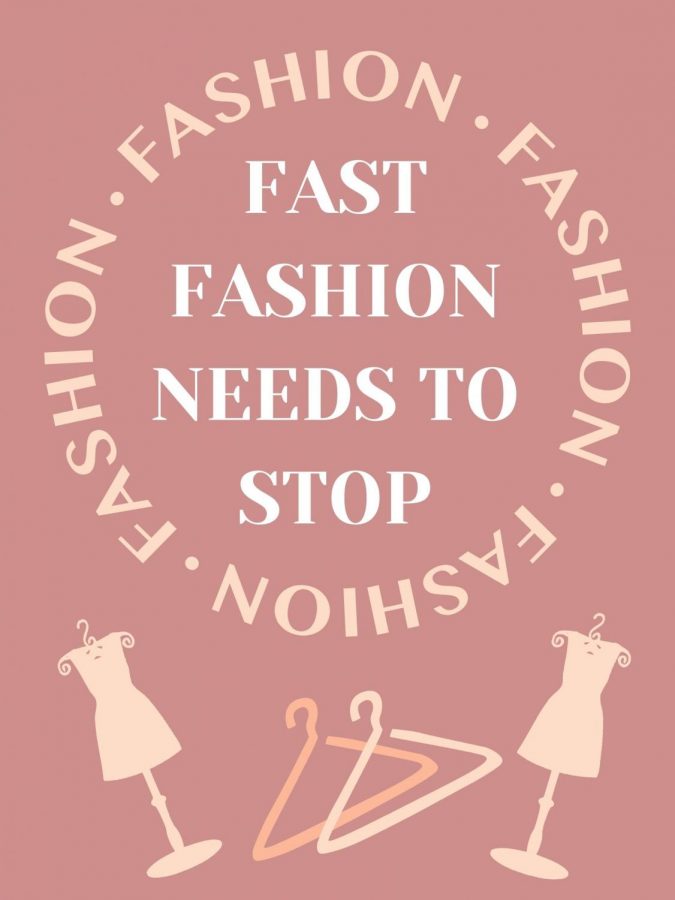Fast Fashion: The Effects of Uber-Industrialization
September 17, 2021
Clothes.
We wear them to protect our skin from the freezing cold and the blistering heat. But they don’t just serve as protection—clothes provide a valuable form of self-expression for many individuals. The popularity of this mode of creativity has contributed to the fashion industry’s approximate 1.9 trillion USD value in the United States alone.
However, environmental and humanitarian crises are arising from the increasing demand of one particular branch of apparel you may have heard of; fast fashion.
So, what is fast fashion?
Solene Rauturier from Good On You describes fast fashion as “cheap, trendy clothing” that takes inspiration from catwalks, celebrity fashion, and designer brands and creates knockoff garments that are aimed to reach general franchises as quickly as possible. The outfits are typically characterized by fleeting trends and are usually only worn a few times before being discarded. This idea of staying relevant to the current fad has not only resulted in massive pollution from the excessive waste, but also the consequences of exploiting third-world countries and their manual workforce, some of which can be fatal.
Fast-er fashion came into play through the Industrial Revolution from the late-1700s to the mid-1800s. Fashion production before that was understandably slow, and not all that much cared for in terms of quantity by the working class, who were probably more focused on how to even get by daily. Then, the sewing machine came along—clothes were suddenly much easier, cheaper, and quicker to produce and sell. Dressmaking shops for the middle-class became more of a norm, employing masses of garment workers. However, this rise of industrialized fashion coincided with the emergence of sweatshops. The industry experienced the negatives of large-scale manufacturing, such as the 1911 Triangle Shirtwaist Factory fire in New York, killing 146 garment workers, most of whom were female immigrants.
Progressing into the 1960s and 70s, where self-expression was popularized within fashion, the average person bought less than 25 clothes a year, 95% of which were manufactured within the U.S. itself. There was still some sort of line between “high fashion and high street”. And then, just like the sewing machine, an innovation was introduced that revamped the industry’s landscape: online shopping.
Between the late 90s and 2000s, retailers like Zara and H&M boomed. With the convenience of a few clicks on your computer, buying clothes became more of regularity, and the rise of fast consumption synced with the rise of fast production. This culture is amplified in today’s society, where social media is at the highest point it’s ever been at, with apps like TikTok and their algorithms helping things trend massively for a brief period, from music to books to food to fashion.
The fast fashion industry’s impact on the environment is undeniably scary. As consumers continue to buy and trash at a lightning pace, landfills pile up high, and eventually, the waste has to be incinerated, where the toxic substances pose harm to the health of the public. Furthermore, fast fashion companies’ need for quick and cheap manufacturing leads them to brush over environmental maintenance, like using harmful dyes which pollute clean waters and also affect the inhabitants of those ecosystems.
The humanitarian problems that arise from fast fashion are just as vast and serious. Executives want to cut moral corners to make profit and overlook potentially deadly conditions in the factories of the developing countries they take advantage of. In 2013, over 1,000 workers were killed in the Dhaka garment factory collapse in Bangladesh, raising questions about the safety of the actual buildings in which fast fashion production takes place. The majority employment of women in clothing factories in countries such as Bangladesh, Cambodia, Indonesia, and Sri Lanka under the management of mainly men has resulted in disgusting acts of injustice. Gender-based violence can take the form of physical, mental, and sexual harm, and it’s difficult for workers to speak up against the male-dominated employers in such a structurally oppressive system.
Fast fashion enforces this mentality of constant dissatisfaction, which is also, strangely enough, what makes it so addicting. As we race to keep up with what is “in”, we tend to forget about what we would choose to wear without that outside stimulus. Self-expression is being washed out in favor of societal assimilation. Although buying clothes and enjoying different fashion is not inherently bad, you should hold yourself responsible during the process. The next time you throw away that top you wore twice, or buy the skirt you don’t even like but saw people donning on your feed, think about the waste being dumped into a river, the thousands of creatures in it dying, the women who work tirelessly despite the abuse of their managers. Think about the consequences of something that may seem inconsequential to you, because it could just cost a life.







